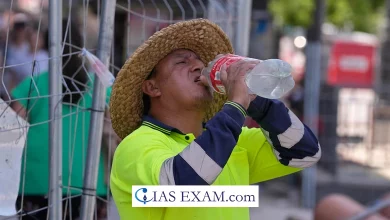Daily Current Affairs for UPSC
Concerns over Carbon Markets

Topic- Environment and Ecology [GS Paper-3]
Context- Recently, the Parliament has passed the Energy Conservation (Amendment) Bill, 2022 on declining the Opposition’s demands to send it for scrutiny to a parliamentary committee and amid concerns expressed by members over carbon markets.
Key Highlights
- Carbon Markets is a mitigation strategy which is becoming popular with several countries to meet their nationally determined contributions (NDCs).
- Article 6 of the Paris Agreement provides for the use of international carbon markets by countries in order to fulfill their NDCs.
- The U.N. international carbon market envisioned in Article 6 of the Paris Agreement has not yet kicked off as multilateral discussions are still underway about how the inter-country carbon market will function.
- Under the market, countries would be able to offset their emissions by buying credits generated by greenhouse gas-reducing projects in other countries.
Significance
- Carbon markets act as a tool for putting a price on carbon emissions.
- The markets establish trading systems where carbon credits or allowances can be bought and sold.
- A United Nations Development Program (UNDP) release this year noted that interest in carbon markets is growing globally, i.e, 83% of NDCs submitted by countries mention their intent to make use of international market mechanisms in order to reduce greenhouse gas emissions.
- The World Bank states that trading in carbon credits could reduce the cost of implementing NDCs by more than half — by as much as $250 billion by 2030.
Carbon Credit
- A carbon credit is a kind of tradable permit that, per UN standards, equals one tonne of carbon dioxide removed, reduced, or sequestered from the atmosphere.
Carbon allowances or caps
- Caps are determined by countries or governments according to their emission reduction goals.
Types of Carbon Markets
-
- Voluntary markets
- Here, emitters such as corporations, private individuals, and others buy carbon credits to offset the emission of one tonne of CO2 or equivalent greenhouse gases.
- Such carbon credits are created by activities which reduce CO2 from the air, like afforestation.
- In this type of market, a corporation looking to compensate for its unavoidable GHG emissions purchases carbon credits from an entity engaged in projects that reduce, remove, capture, or avoid emissions.
- In voluntary markets, credits are verified by the private firms as per popular standards. There are also traders and online registries where climate projects are listed and certified credits can be bought.
- As for these carbon markets, their current global value is comparatively smaller at $2 billion.
- Voluntary markets
- Compliance Markets:
-
-
- These markets are set up by policies at the national, regional, and/or international level— are officially regulated.
- Compliance markets mostly operate under a principle called ‘cap-and-trade” and it is most popular in the European Union (EU).
- Under the emissions trading system (ETS) of the EU launched in 2005, member countries set a cap or limit for emissions in different sectors, such as power, oil, manufacturing, agriculture, and waste management.
- The cap is determined as per the climate targets of countries and is lowered successively to reduce emissions.
- Last year, the value of global markets for tradeable carbon allowances or permits increased by 164% to a record 760 billion euros ($851 billion), according to an analysis by Refinitiv.
- The ETS of the EU contributed the most to this increase, accounting for 90% of the global value at 683 billion euros.
-
- Other national and sub-national compliance carbon markets:
-
- China has launched the world’s largest ETS in 2021, estimated to cover around one-seventh of the global carbon emissions from the burning of fossil fuels.
- Markets are under development in North America, Australia, Japan, South Korea, Switzerland, and New Zealand.
Challenges to carbon markets
- Questionable Authenticity & Double Counting:
-
-
- The UNDP points out crucial concerns pertaining to carbon markets- ranging from double counting of greenhouse gas reductions and quality and authenticity of climate projects that generate credits to poor market transparency.
- Greenwashing:
- There are concerns about what critics call greenwashing where companies may buy credits, simply offsetting carbon footprints instead of reducing their overall emissions or investing in clean technologies.
-
- Lack of Transparency:
-
-
- The UNDP emphasises that for carbon markets to be successful, “emission reductions and removals should be real and aligned with the country’s NDCs”.
- It states that there must be “transparency in the institutional and financial infrastructure for carbon market transactions”.
-
- No Guarantee of Climate Mitigation:
-
- As for regulated or compliance markets, ETSs may not automatically reinforce the climate mitigation instruments.
- The International Monetary Fund also points out that including high emission-generating sectors under trading schemes to offset their emissions by buying allowances may increase emissions on net and provide no automatic mechanism for prioritizing cost-effective projects in the offsetting sector
Energy Conservation (Amendment) Bill, 2022
- The Bill empowers the Centre to formulate a carbon credits trading scheme.
- Under the provisions of the Bill, the central government or an authorised agency will issue carbon credit certificates to companies or even individuals registered and compliant with the scheme.
- These carbon credit certificates will be tradeable in nature and other persons would be able to buy carbon credit certificates on a voluntary basis.
- However the Bill does not provide clarity on the mechanism to be used for the trading of carbon credit certificates— whether it will be like the cap-and-trade schemes or use another method— and who will regulate such trading.
- Members also raised questions about the right ministry to formulate a scheme of this nature, pointing out that while carbon market schemes in other jurisdictions like the U.S., United Kingdom, and Switzerland are framed by their environment ministries, the Indian Bill was tabled by the power ministry instead of the Ministry of Environment, Forest, and Climate Change (MoEFCC).
- Also the Bill does not specify whether certificates under already existing schemes would also be interchangeable with carbon credit certificates and tradeable for reducing carbon emissions.
- Two types of tradable certificates are already issued in India i.e. Renewable Energy Certificates (RECs) and Energy Savings Certificates (ESCs).
- These certificates are issued when companies use renewable energy or save energy, which are also activities which reduce carbon emissions.
- Hence the question is whether all these certificates could be exchanged with each other.
- There are also concerns about whether overlapping schemes may dilute the overall impact of carbon trading.
Way Ahead
- India needs to align public financial flows with announced targets on energy transition, in order to leverage private finance.





.png)



